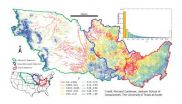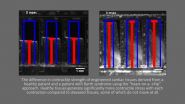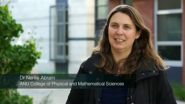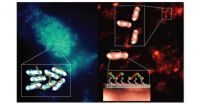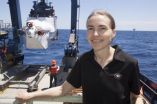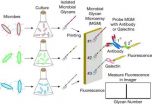(Press-News.org) At the surface, Antarctica is a motionless and frozen landscape. Yet hundreds of miles down the Earth is moving at a rapid rate, new research has shown.
The study, led by Newcastle University, UK, and published this week in Earth and Planetary Science Letters, explains for the first time why the upward motion of the Earth's crust in the Northern Antarctic Peninsula is currently taking place so quickly.
Previous studies have shown the earth is 'rebounding' due to the overlying ice sheet shrinking in response to climate change. This movement of the land was understood to be due to an instantaneous, elastic response followed by a very slow uplift over thousands of years.
But GPS data collected by the international research team, involving experts from Newcastle University, UK; Durham University; DTU, Denmark; University of Tasmania, Australia; Hamilton College, New York; the University of Colorado and the University of Toulouse, France, has revealed that the land in this region is actually rising at a phenomenal rate of 15mm a year – much greater than can be accounted for by the present-day elastic response alone.
And they have shown for the first time how the mantle below the Earth's crust in the Antarctic Peninsula is flowing much faster than expected, probably due to subtle changes in temperature or chemical composition. This means it can flow more easily and so responds much more quickly to the lightening load hundreds of miles above it, changing the shape of the land.
Lead researcher, PhD student Grace Nield, based in the School of Civil Engineering and Geosciences at Newcastle University, explains: "You would expect this rebound to happen over thousands of years and instead we have been able to measure it in just over a decade. You can almost see it happening which is just incredible.
"Because the mantle is 'runnier' below the Northern Antarctic Peninsula it responds much more quickly to what's happening on the surface. So as the glaciers thin and the load in that localised area reduces, the mantle pushes up the crust.
"At the moment we have only studied the vertical deformation so the next step is to look at horizontal motion caused by the ice unloading to get more of a 3-D picture of how the Earth is deforming, and to use other geophysical data to understand the mechanism of the flow."
Since 1995 several ice shelves in the Northern Antarctic Peninsula have collapsed and triggered ice-mass unloading, causing the solid Earth to 'bounce back'.
"Think of it a bit like a stretched piece of elastic," says Nield, whose project is funded by the Natural Environment Research Council (NERC). "The ice is pressing down on the Earth and as this weight reduces the crust bounces back. But what we found when we compared the ice loss to the uplift was that they didn't tally – something else had to be happening to be pushing the solid Earth up at such a phenomenal rate."
Collating data from seven GPS stations situated across the Northern Peninsula, the team found the rebound was so fast that the upper mantle viscosity - or resistance to flow - had to be at least ten times lower than previously thought for the region and much lower than the rest of Antarctica.
Professor Peter Clarke, Professor of Geophysical Geodesy at Newcastle University and one of the authors of the paper, adds: "Seeing this sort of deformation of the earth at such a rate is unprecedented in Antarctica. What is particularly interesting here is that we can actually see the impact that glacier thinning is having on the rocks 250 miles down."
INFORMATION: END
Ice-loss moves the Earth 250 miles down
2014-05-12
ELSE PRESS RELEASES FROM THIS DATE:
Green-energy community projects need better government backing
2014-05-12
Community-led sustainable energy projects are not taken seriously enough by the government, according to a new report from the University of East Anglia.
Published today, the report looks at how initiatives such as community-owned solar panels, wind turbines and hydro-electricity generators, as well as energy-saving projects, could make big differences in tackling climate change.
But while a 'Big Society' ethos has formed part of the legislative programme for the coalition government, and the UK Government's new Community Energy Strategy has been a big step forward ...
Atlas shows how genes affect our metabolism
2014-05-11
In the most comprehensive exploration of the association between genetic variation and human metabolism, researchers have provided unprecedented insights into how genetic variants influence complex disease and drug response through metabolic pathways.
The team has linked 145 genetic regions with more than 400 molecules involved in human metabolism in human blood. This atlas of genetic associations with metabolism provides many new opportunities to understand the molecular pathways underlying associations with common, complex diseases.
Metabolic molecules, known as metabolites, ...
Flexible supercapacitor raises bar for volumetric energy density
2014-05-11
Scientists have taken a large step toward making a fiber-like energy storage device that can be woven into clothing and power wearable medical monitors, communications equipment or other small electronics.
The device is a supercapacitor—a cousin to the battery. This one packs an interconnected network of graphene and carbon nanotubes so tightly that it stores energy comparable to some thin-film lithium batteries—an area where batteries have traditionally held a large advantage.
The product's developers, engineers and scientists at Nanyang Technological University (NTU) ...
Hydrologists find Mississippi River network's buffering system for nitrates is overwhelmed
2014-05-11
AUSTIN, Texas – A new method of measuring the interaction of surface water and groundwater along the length of the Mississippi River network adds fresh evidence that the network's natural ability to chemically filter out nitrates is being overwhelmed.
The research by hydrogeologists at The University of Texas at Austin, which appears in the May 11 edition of the journal Nature Geoscience, shows for the first time that virtually every drop of water coursing through 311,000 miles (500,000 kilometers) of waterways in the Mississippi River network goes through a natural ...
Patient stem cells used to make 'heart disease-on-a-chip'
2014-05-11
Cambridge, MA—Harvard scientists have merged stem cell and 'organ-on-a-chip' technologies to grow, for the first time, functioning human heart tissue carrying an inherited cardiovascular disease. The research appears to be a big step forward for personalized medicine, as it is working proof that a chunk of tissue containing a patient's specific genetic disorder can be replicated in the laboratory.
The work, published in Nature Medicine, is the result of a collaborative effort bringing together scientists from the Harvard Stem Cell Institute, the Wyss Institute for Biologically ...
Ocean winds keep Antarctica cold, Australia dry
2014-05-11
VIDEO:
Dr. Nerlie Abram, from the Australian National University, explains why ocean winds have stopped Antarctica from warming as much as other continents. Her research also explains droughts in Southern Australia.
Click here for more information.
New Australian National University-led research has explained why Antarctica is not warming as much as other continents, and why southern Australia is recording more droughts.
Researchers have found rising levels of carbon dioxide ...
Hijacking bacteria's natural defences to trap and reveal pathogens
2014-05-11
The breakthrough, published in the journal Nature Materials, could offer an easier way of detecting pathogenic bacteria outside of a clinical setting and could be particularly important for the developing world, where access to more sophisticated laboratory techniques is often limited.
The research was led by Professor Cameron Alexander, Head of the Division of Drug Delivery and Tissue Engineering and EPSRC Leadership Fellow in the University's School of Pharmacy, building on work by PhD student Peter Magennis. Professor Alexander said: "Essentially, we have hijacked ...
UGA research examines fate of methane following the Deepwater Horizon spill
2014-05-11
Athens, Ga. – The 2010 Deepwater Horizon blowout discharged roughly five million gallons of oil and up to 500,000 tons of natural gas into Gulf of Mexico offshore waters over a period of 84 days. In the face of a seemingly insurmountable cleanup effort, many were relieved by reports following the disaster that naturally-occurring microbes had consumed much of the gas and oil.
Now, a team of researchers led by University of Georgia marine scientists have published a paper in the journal Nature Geoscience that questions this conclusion and provides evidence that microbes ...
Galectins direct immunity against bacteria that employ camouflage
2014-05-11
Our bodies produce a family of proteins that recognize and kill bacteria whose carbohydrate coatings resemble those of our own cells too closely, scientists have discovered.
Called galectins, these proteins recognize carbohydrates from a broad range of disease-causing bacteria, and could potentially be deployed as antibiotics to treat certain infections. The results are scheduled for publication in Nature Chemical Biology.
Researchers at Emory University School of Medicine made the discovery with the aid of glass slides coated with an array of over 300 different glycans ...
Study finds patients AFib at higher risk of dementia when meds out of range
2014-05-10
A new study by researchers at the Intermountain Medical Center Heart Institute in Salt Lake City has found that atrial fibrillation patients who are on blood thinning medications are at higher risk of developing dementia if their doses are not in the optimal recommended range.
The study of more than 2,600 AFib patients found they are significantly more likely to develop dementia when using medicines to prevent blood clots, such as warfarin, when their dosing is too high or too low for an extended period of time.
Findings from the study will be presented at the 2014 ...
